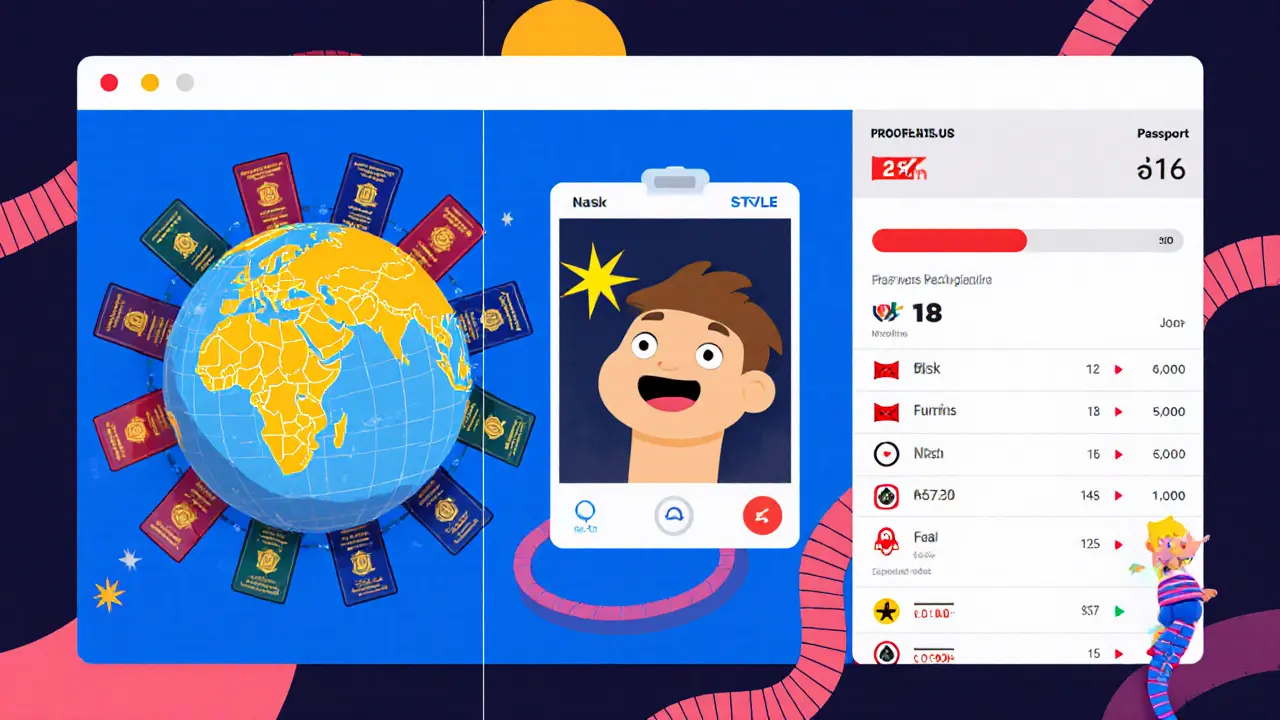Persona KYC Review: Is It the Right Crypto Exchange Verification Solution?

Sep, 23 2025
KYC Cost Calculator
Calculate Your Savings
Estimate potential cost savings by comparing Persona KYC with competitors based on your verification volume.
Results
When a crypto exchange wants to stay on the right side of regulators while keeping new users from bouncing at sign‑up, the choice of KYC provider becomes a make‑or‑break decision. Persona KYC has been marketed as the crypto‑native answer, but does it live up to the hype? This review breaks down the service, compares it with major rivals, and tells you exactly when it makes sense to adopt it.
What is Persona?
Persona is a B2B identity verification platform built specifically for cryptocurrency exchanges and other regulated financial services. Founded in 2018 by Rick Song, Haisam Shinweh, and Jack Liu, the company focuses on turning KYC from a compliance hurdle into a growth lever. Unlike a traditional exchange, Persona does not hold or trade crypto; instead, it supplies the verification engine that powers the onboarding flow of the exchange.
Why crypto exchanges need a dedicated KYC solution
Regulators worldwide are tightening the reins. The EU’s MiCA framework, FATF’s Travel Rule, and US AML expectations all demand real‑time, accurate identity checks. At the same time, a clunky verification process can drop conversion rates by up to 30 % according to industry surveys. Exchanges therefore need a tool that can:
- Validate government IDs from more than 200 countries.
- Run biometric selfie checks with liveness detection.
- Screen users against sanctions and watchlists (OFAC, EU, UN).
- Support tiered verification - basic for small trades, enhanced for large withdrawals.
- Integrate quickly with existing APIs and webhooks.
Persona claims to check all those boxes while keeping the UI smooth enough that users actually finish the flow.
Key features of Persona
Below are the core capabilities that matter most to exchange operators:
- Global ID verification: Supports passports, driver’s licenses, and national ID cards from 200+ jurisdictions.
- Biometric selfie with liveness detection: Reduces spoofing attacks and complies with e‑KYC standards in the EU and Singapore.
- Proof‑of‑address checks: Automated document parsing for utility bills, bank statements, or government letters.
- Watchlist screening: Real‑time cross‑referencing against sanctions lists, PEP databases, and FATF high‑risk entities.
- Risk‑based tiering: Allows exchanges to define custom verification steps based on transaction volume, geographic risk, or user‑chosen account type.
- API‑first architecture: RESTful endpoints with average response times under 800 ms for 95 % of requests, plus webhook callbacks for status updates.
- Multi‑language UI: 20 language packs out‑of‑the‑box, making it easier to onboard users from Asia, Latin America, and Europe.
- Analytics dashboard: Real‑time funnel visualization that highlights where users drop off during verification.
All of these pieces are documented in the public API reference, which includes sample code in JavaScript, Python, Ruby, Go, Java, and .NET.
How Persona stacks up against competitors
In the crowded KYC market, the biggest names are Onfido, Jumio, and Sumsub. The table below uses publicly disclosed metrics and third‑party analyst data (Blockchain Research Institute, Gartner, Forrester) to compare the four providers on the dimensions that matter most to crypto exchanges.
| Provider | Verification completion rate | Avg. response time (ms) | Price per check (USD) | Language support | Crypto‑specific features |
|---|---|---|---|---|---|
| Persona | 87.3 % | ≈750 | 0.25 (volume tiered) | 20 | Tiered risk flows, wallet screening, MiCA compliance modules |
| Onfido | 78.1 % | ≈920 | 0.30-0.45 | 15 | Standard ID checks, limited crypto‑specific rules |
| Jumio | 80.4 % | ≈880 | 0.32 (enterprise) | 18 | Document + facial match, no built‑in wallet screening |
| Sumsub | 82.7 % | ≈800 | 0.28 (volume) | 22 | AML transaction monitoring, limited crypto workflow templates |
Persona’s 87 % completion rate is the highest among the four, largely because its UI is built with a crypto audience in mind. The response times are comparable, but the ability to embed custom risk tiers gives exchanges a lever to balance compliance cost and user friction.
Pricing and cost considerations
Persona follows a usage‑based model starting at $0.25 per verification for high‑volume contracts. There are no setup fees or minimum monthly commitments, which is a relief for emerging exchanges that may only process a few thousand verifications a month. Larger players can negotiate enterprise rates that drop below $0.10 per check when volumes exceed 2 million per quarter.
In contrast, Onfido and Jumio tend to charge $0.30-$0.45 per verification and often bundle in a minimum monthly fee. Sumsub is slightly cheaper per unit but adds extra fees for advanced AML monitoring modules.
When you crunch the numbers, an exchange that processes 500,000 verifications annually could save roughly $125,000 with Persona versus Onfido, assuming comparable conversion rates.

Implementation experience: real‑world case studies
Several top‑20 global exchanges have publicly shared their results after switching to Persona. One unnamed exchange reported a 100 % jump in successful verifications within the first two weeks, translating to an estimated $2.3 million extra monthly revenue. The secret? A custom tier that required only a photo ID for deposits under $5,000, while larger withdrawals triggered full biometric and wallet checks.
Reddit’s r/cryptomarkets community echoed similar sentiments, with users praising the dashboard’s funnel analytics. A common pain point, however, is the initial engineering effort. HackerNews threads note that while the API docs are thorough, setting up risk‑based flows can demand 16-20 hours of developer time-still a manageable investment for most mid‑size teams.
Persona’s support model includes a dedicated technical account manager, 24/7 critical‑issue response, and quarterly business reviews. These services help smooth out the early‑stage learning curve and keep compliance updates aligned with regulatory changes.
Pros, cons, and who should use Persona
Pros
- High verification completion rate (87 %+).
- Crypto‑specific workflow customization.
- No upfront setup fees; flexible pricing.
- Fast API response times and 99.95 % uptime.
- Strong multilingual support for global user bases.
Cons
- Relatively newer vendor-fewer legacy banking integrations.
- Implementation complexity for very small teams without dev resources.
- Pricing can climb for low‑volume customers if they don’t negotiate.
Best fit
Persona shines for exchanges that:
- Serve retail users across multiple geographies.
- Need to iterate quickly on verification flows (e.g., new token listings).
- Want to turn compliance into a growth metric rather than a bottleneck.
Legacy institutions that rely heavily on existing banking partners may prefer a more established provider like Jumio or Onfido, which already have deep integrations with legacy cores.
Future outlook and roadmap
Persona announced expanded MiCA support and decentralized‑identity (DID) features for Q4 2024. If those modules roll out as promised, the platform could become one of the few KYC providers that bridge on‑chain identity with off‑chain verification-a potential game‑changer for DeFi platforms. Analysts from Forrester and Gartner expect crypto‑native KYC vendors to capture over 40 % of the market by 2026, and Persona’s rapid growth (63 % YoY) puts it in a strong position.
Regulatory risk remains a factor: stricter enforcement of the Travel Rule may push exchanges toward providers that can prove audit‑ready data pipelines. Persona’s documentation already includes immutable logs, but continued investment in chain‑anchored audit trails will be crucial.
Bottom line
If you run a crypto exchange that values both compliance and conversion, Persona offers a compelling mix of high completion rates, flexible risk tiers, and competitive pricing. The initial integration effort is real, but most teams recoup that time quickly thanks to higher user onboarding success. For newer exchanges looking to scale fast, it’s worth a serious test run.

What types of IDs does Persona verify?
Persona can validate passports, driver’s licenses, national ID cards, and residence permits from more than 200 countries. The system uses OCR and AI‑based liveness detection to confirm authenticity.
How does Persona’s pricing compare to other KYC providers?
Persona starts at $0.25 per verification with volume discounts and no minimum fees. Competitors like Onfido and Jumio usually charge $0.30-$0.45 per check and often require a baseline monthly spend.
Can Persona handle AML monitoring for large transactions?
Yes. Persona’s risk‑based tiers let you trigger additional AML checks-such as watchlist screening and transaction pattern analysis-once a user exceeds a predefined threshold.
Is there a free trial or pilot program?
Persona offers a limited‑use sandbox environment for developers, and many exchanges start with a short‑term pilot that can be scaled to production after the initial integration phase.
What support does Persona provide during onboarding?
Each client gets a dedicated technical account manager, 24/7 critical‑issue response, and access to a developer community of over 1,200 members. Documentation includes code samples in six major programming languages.